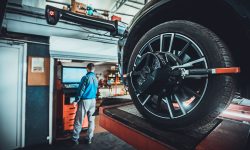3 Reasons Why Independent Automotive Shops Need to Evaluate Door Rates

Why Prioritizing Profitability Doesn’t Have to Mean Sacrificing Customers
While car dealerships are constantly working to keep their labor rates in line with market demand, often raising costs for customers as a result, smaller independent shops do not operate in the same manner. For many, especially mom-and-pop repair operations that have been around for generations, keeping prices low for customers is a top priority.
Although that comes with a fair amount of customer appreciation, the issue is the practice can leave thousands on the table each year for businesses, said SCL Customer Solutions Representative Don Parker, who holds over 40 years of experience in the automotive industry.
“Dealerships are constantly obsessing over their bottom lines, and part of the equation they use to do that is their ‘door rate,’ the per hour rate for technician time,” Parker said. “Managers take into account OEM flat rate manuals and industry leading guides for how long jobs should take, while labor rate takes into account cost of sale and gross profit margin. All of that, in addition to what competitors down the street and elsewhere in the market are charging, should be a barometer for independent shops. Right now, by and large, they don’t take those factors into account. Instead, they charge what they have always charged for years while still providing the same high quality of work. With labor and business costs rapidly increasing and profitability decreasing, that means they could be leaving a lot on the table. Frankly, now is not the time to do that.”
Here are three reasons why re-evaluating your door rate can help you increase profitability of your independent shop without sacrificing business.
1. Market competitiveness – Taking stock of what your competitors are charging and then adjusting your prices accordingly helps the entire market, Parker said. Lower-than-average rates could mean more customers coming through your door, but it can also equate to more strain on your technicians and higher customer wait times while also sacrificing profits. “I encourage independent shops to do their own leg work – call around to shops and ask their door rates so that you can get an idea of what others are charging and maybe how you can adjust your rates accordingly. Keeping prices low for your customers is noble and I’m sure customers appreciate it, but at some point, if you’re not bringing in profit you’re not going to survive long enough to keep taking care of them.”
2. Customer loyalty – Instead of looking at adjusting your prices as something that could potentially drive customers away, look at it as an opportunity to have a conversation with them about the impeccable service you have always delivered and will continue to deliver. While they may have come to an independent automotive shop because they didn’t want to pay the higher costs dealerships typically charge, they stayed because of the customer service and the quality of work that was done on their vehicle. “Independent shops are usually going to be able to stay well under dealer prices anyway because their expenses are not as high,” Parker said. “After years and years of doing this one thing I’ve come to find is that people don’t leave based on price. They may come to you based on price, but they don’t leave based on price. They leave because their service or the work you did on their vehicle wasn’t up to par. As long as you maintain those two elements, you shouldn’t be afraid to raise your prices to what the market is doing. Customers are going to be looking at who is treating them the best.”
3 Profitability – The largest reason to evaluate your door rate based on the industry and the local market is profitability. “You can have customers lined up outside your door, but if you’re charging well under market value for the services you provide, then you are losing money, that’s the bottom line,” Parker said. “If you’re losing money, then you’re not able to pay your technicians what they can find elsewhere – especially when we already know technicians are in demand – and you risk not staying around long term to take care of your customers the way you want to anyway.” According to AAA, as of 2017, automotive repair shops in the organization’s network charged between $47 and $215 per hour. In San Diego County, Parker said, they range between $150-170 or more. “That’s where independent shops really have to step in and do their own due diligence to learn what’s happening at the shops and dealerships around them, what percentage of profit they want to bring in based on the work that they do, and then go from there,” he said. “The most important step is making that evaluation a priority.”
Contact an SCL Consultant today
In a wide range of automotive, industrial and commercial sectors, SCL remains steadfast in its commitment to product and industry knowledge, performance satisfaction and superior logistics. We protect and optimize the machines that keep our country moving. For more information on how we can help with services including bulk purchasing or managing inventory, contact an SCL expert today.
